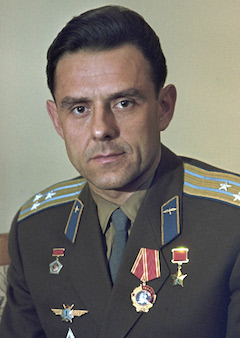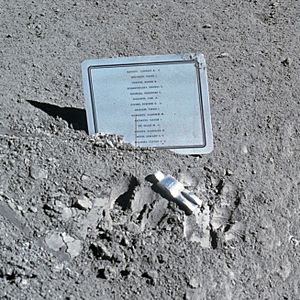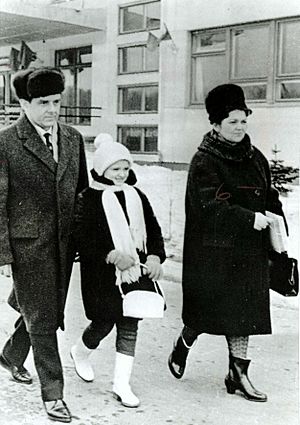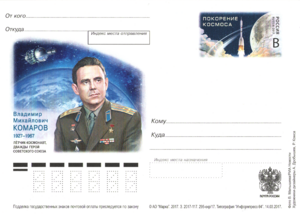Vladimir Komarov facts for kids
Quick facts for kids
Vladimir Komarov
|
|
|---|---|

Komarov in 1964
|
|
| Born | 16 March 1927 |
| Died | 24 April 1967 (aged 40) Orenburg Oblast, Russian SFSR, Soviet Union
|
| Resting place | Kremlin Wall Necropolis |
| Nationality | Soviet |
| Occupation | Engineer |
| Awards | Hero of the Soviet Union (twice) |
| Space career | |
| Cosmonaut | |
| Rank | Polkovnik (equiv. Colonel), Soviet Air Force |
|
Time in space
|
2d 03h 04m |
| Selection | Air Force Group 1 |
| Missions | Voskhod 1, Soyuz 1 |
| Signature | |
 |
|
Vladimir Komarov (born March 16, 1927 – died April 24, 1967) was a brave Soviet test pilot, engineer, and astronaut (called a cosmonaut in the Soviet Union). In October 1964, he led the Voskhod 1 mission. This was the first time more than one person flew into space together. He also became the first Soviet cosmonaut to fly in space twice. His second flight was as the pilot of Soyuz 1, which was its first test flight with a crew. Sadly, a problem with the parachute caused his Soyuz capsule to crash when it returned to Earth on April 24, 1967. This made him the first human to die during a space mission.
Even though he was told twice that he was not healthy enough for training or spaceflight, he kept working hard. He helped design spacecraft, train other cosmonauts, and even worked on public relations.
Contents
Growing Up and Early Life
Komarov was born in Moscow on March 16, 1927. He grew up with his older half-sister, Matilda. His father worked many low-paying jobs to support their family. In 1935, Vladimir started elementary school. He was very good at mathematics.
In 1941, Komarov had to leave school because of World War II. Germany had invaded the Soviet Union. He started working on a collective farm. From a young age, he loved aeronautics, which is the study of flight. He collected magazines and pictures about aviation. He even built model aircraft and his own propeller.
When he was fifteen in 1942, Komarov joined the "1st Moscow Special Air Force School." He wanted to become a pilot. Soon after, his family learned that his father had died in the war. Because of the German invasion, the flight school moved to the Tyumen region in Siberia. Students there learned many subjects, including zoology and foreign languages. In 1945, Komarov finished flight school with high honors. Luckily, World War II ended before he had to go into combat.
In 1946, Komarov finished his first year of training at the Chkalov Higher Air Force School. He then completed his training at the A.K. Serov Military Aviation College. Komarov's mother died in 1948. In 1949, he graduated and became a lieutenant in the Soviet Air Force.
Becoming a Soviet Air Force Pilot
In December 1949, Komarov flew fighter planes. He was part of the 383rd Regiment in Grozny.
Komarov married Valentina Yakovlevna Kiselyova in October 1950. In 1952, he was promoted to senior lieutenant. Later, he became the chief pilot of the 486th Fighter Aviation Regiment. Komarov flew in this role until 1954. Then, he joined an engineering course at the Zhukovsky Air Force Engineering Academy. In 1959, he became a senior engineer-lieutenant. Later that year, he achieved his goal of becoming a test pilot.
Becoming a Cosmonaut
Joining the First Cosmonaut Group
In September 1959, Komarov was promoted to engineer-captain. He was invited to try out for the cosmonaut program. About 3,000 other pilots also applied. He was one of twenty pilots chosen for "Air Force Group One." They reported to the new TsPK (Yuri Gagarin Cosmonaut Training Center) near Moscow on March 13, 1960.
Komarov was very skilled. However, he was not chosen for the top six candidates. This was because he did not meet the age, height, and weight rules set by the space program's Chief Designer, Sergei Korolev. Komarov was 32, but Korolev wanted pilots no older than 27. Komarov had a lot of flight experience and was an engineer. He had a big impact on the design of the 'Vostok' and 'Voskhod' spacecraft.
Cosmonaut Training
Soon after starting his training, Komarov had a small operation in May 1960. This meant he could not do physical training for about six months. At that time, being in perfect physical shape was very important for cosmonauts. Any small problem could lead to being removed from the program. But Komarov was allowed to stay because he was already an engineer. He promised to catch up. He continued his studies while he got better. He returned to training in October, faster than doctors expected. During this time, he helped younger trainees with their studies. This earned him the nickname "The Professor."
In 1961, the first space flights began. By 1962, Komarov was the third-highest-paid cosmonaut. This was because of his skills, rank, and experience. He earned 528 rubles a month. Only Yuri Gagarin and Gherman Titov earned more.
Komarov was chosen as a backup for Pavel Popovich for a Vostok mission. However, a routine heart test showed an irregular heartbeat. He was removed from the program and replaced by Boris Volynov. Komarov kept asking doctors and military staff to let him back into the program. Finally, they allowed him to return to training.
In 1963, Komarov was in Group 2 for cosmonaut training. This group trained for missions lasting up to five days. In April 1964, Komarov was declared ready for space flight. He was one of the top candidates to command the Voskhod mission.
During training, Komarov lived at the TsPK with his wife Valentina and their two children, Yevgeny and Irina. He enjoyed hunting, skiing, ice hockey, and other activities with his fellow trainees. Komarov was well-liked by his friends. They called him Volodya, which is a friendly version of his first name. Fellow cosmonaut Alexei Leonov said he was "very serious" and "a first-class test pilot."
Space Missions
Voskhod 1 Mission
By July 1964, only seven cosmonauts were left for the Voskhod crew. On October 4, 1964, just eight days before launch, Komarov was chosen as the main commander for Voskhod 1.
On October 9, Komarov and his crew checked the Voskhod spacecraft. They were interviewed by the press and played tennis for photographers.
On October 11, Komarov was given various items to take into space. In the afternoon, the crew checked the capsule again and received their final instructions. Komarov was the only crew member with a lot of training and flight experience. The other two crew members were civilians. His call sign was "Ruby."
During the mission, Komarov and his crew did many tasks. These included medical and navigation tests. They also observed the Aurora Borealis (Northern Lights). Komarov also tested ion thrusters attached to the Voskhod. He made several radio calls, including a greeting to the 1964 Summer Olympics in Tokyo. The mission lasted just over twenty-four hours.
After landing safely, the crew flew back to the launch site. Komarov was tired but in good spirits. On October 19, Komarov and his crew gave reports in Red Square and met with government leaders. After this successful mission, he was promoted to colonel. He also received the Order of Lenin and Hero of the Soviet Union awards.
In 1965, Komarov worked with Yuri Gagarin. They oversaw preparations for the Voskhod 2 flight. This mission included the first extravehicular activity (spacewalk). Komarov also toured different cities and visited historical sites.
Soyuz 1 Mission
Komarov was chosen for the Soviet Soyuz program along with Yuri Gagarin and Alexei Leonov. In July 1966, Komarov was told off for telling people in Japan that the Soviet Union would soon send an automated spacecraft around the Moon. The next month, Komarov argued with engineers about problems with the Soyuz design. Tests showed the hatch was too small for a fully suited cosmonaut to exit safely. Komarov and other cosmonauts were worried about the spacecraft's design. Yuri Gagarin even wrote a letter to Leonid Brezhnev about their concerns.
Komarov was chosen to command the Soyuz 1 mission in 1967. Yuri Gagarin was his backup. During preparations, both cosmonauts worked twelve to fourteen hours a day. After reaching orbit, the Soyuz module's solar panels did not fully open. This meant the craft did not have enough power. It also blocked some navigation equipment. Komarov reported: "Conditions are poor. The cabin is normal, but the left solar panel didn't deploy. The power is low. High frequency communications are not working. I cannot point the spacecraft at the sun." Komarov tried to orient the Soyuz for five hours without success. The craft sent unreliable information. It lost communication for several orbits because the high frequency radio failed.
Because of these problems, the Soviets did not launch the second Soyuz module. Cosmonauts were supposed to do a spacewalk from it to Soyuz 1. The mission was cut short.
Komarov was told to re-orient the craft using special sensors. These sensors failed. Komarov did not have enough time to try a manual re-entry until his 19th orbit. To guide the spacecraft manually, Komarov needed to see the Sun. To land at the planned site, the engines had to fire on the night side of the Earth. Komarov guided the spacecraft manually on the day side. He then used a special device to help him aim for the night side engine firing. He successfully re-entered Earth's atmosphere on his 19th orbit. However, the module's main parachute failed to open correctly. The module crashed into the ground, killing Komarov, at 6:24 a.m.
Awards and Tributes
- Gold Star Hero of the Soviet Union, twice (October 19, 1964, and again in 1967 after his death)
- Order of Lenin (October 19, 1964, and again in 1967 after his death)
- Order of the Red Star (1961)
- Medal "For Combat Merit" (1956)
- Medal "For the Development of Virgin Lands" (1964)
- Pilot-Cosmonaut of the USSR
- Hero of Socialist Labour (North Vietnam, 1964)
Honors After His Death
On April 26, 1967, Komarov had a state funeral in Moscow. His ashes were placed in the Kremlin Wall Necropolis at Red Square. American astronauts asked to attend, but their request was denied.
Komarov was given his second Order of Lenin and Hero of the Soviet Union after his death.
On April 25, 1968, a memorial service was held for Komarov at the crash site near Orsk. More than 10,000 people attended this service.
Komarov has been featured on stamps and special envelopes from different countries. These honor his work in the space program.
A statue of Komarov stands on Cosmonauts Alley in Moscow. He is also honored with a monument at the crash site near Orsk.

Before leaving the Moon on Apollo 11's Lunar Module, astronaut Neil Armstrong placed a small package of memorial items. These honored Soviet cosmonauts Komarov and Yuri Gagarin. They also honored Apollo 1 astronauts Gus Grissom, Ed White, and Roger Chaffee. Komarov's name is also on a plaque left on the Moon by Apollo 15 commander David Scott. This plaque and a small sculpture called Fallen Astronaut honor 14 astronauts and cosmonauts who died exploring space.
The asteroid 1836 Komarov, found in 1971, was named after Komarov. A crater on the Moon also bears his name. The composer Brett Dean was inspired by this asteroid and cosmonaut. He wrote a piece of music called Komarov's Fall in 2006.
The V.M. Komarov Diploma from the Fédération Aéronautique Internationale is named in Komarov's honor.
There was also a Soviet satellite-tracking ship named after Komarov, called the Kosmonaut Vladimir Komarov.
See Also
 In Spanish: Vladímir Mijáilovich Komarov para niños
In Spanish: Vladímir Mijáilovich Komarov para niños
- Apollo 1
- Spacecraft re-entry accidents
- Soyuz 11
- Space Shuttle Columbia disaster



